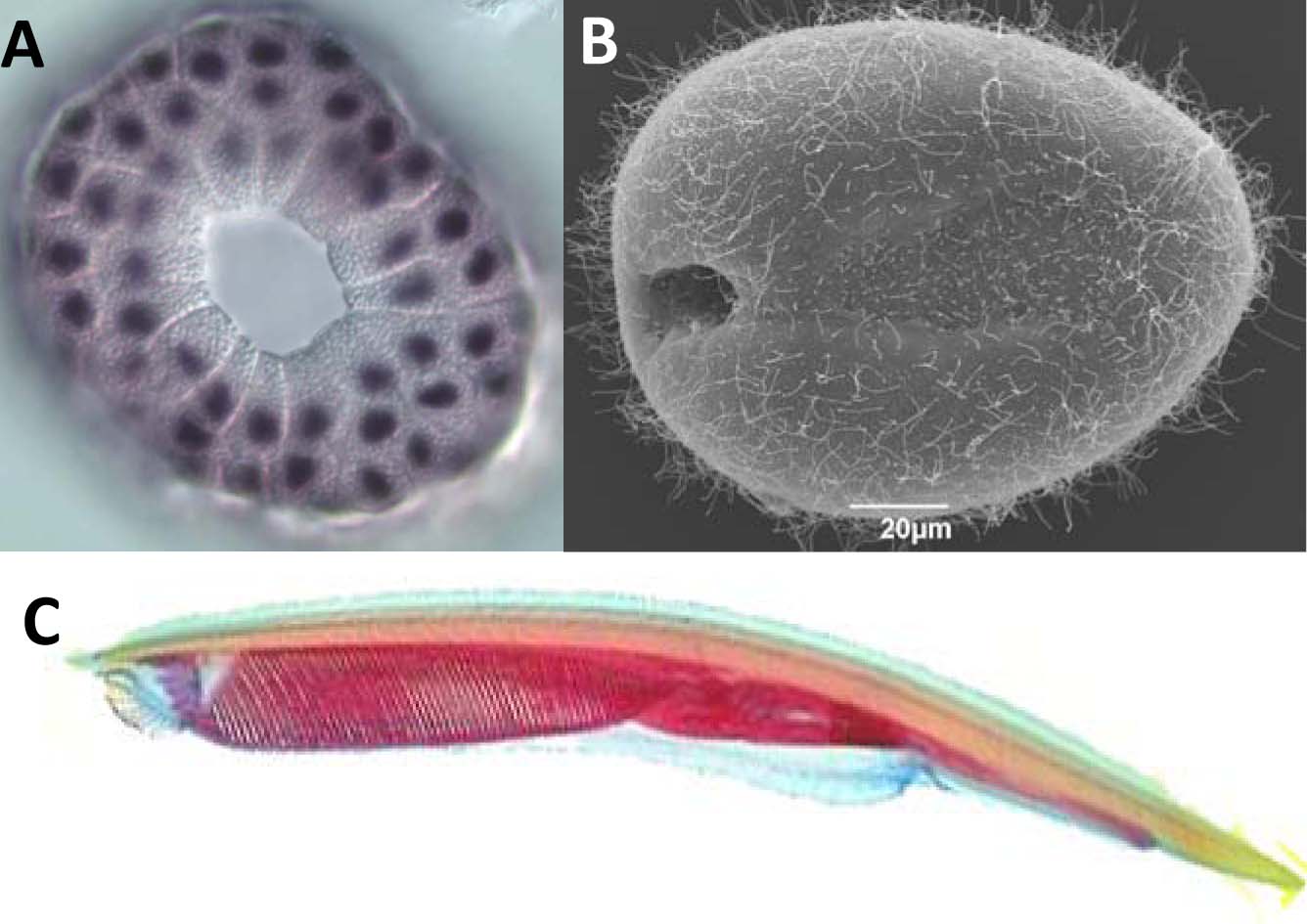Favourite animals
We choose species to study based on their position in the tree of life, and on our ability to obtain samples for genomic and transcriptomic analyses and embryos for experimental investigation. Over the years this has included species from at least 10 different Phyla (including Porifera, Cnidaria, Annelida, Mollusca, Rotifera, Platyhelminthes, Tardigrada, Arthropoda, Echinodermata and Chordata). However we focus on a smaller number, providing insight into two key periods in animal evolution; the origin of bilaterians and the origin of vertebrates.
Lampreys
Lampreys are jawless fish, and with hagfish the earliest branching group of living vertebrates (Shimeld and Donoghue 2012). As their name suggests, they split from the vertebrate tree before typical vertebrate features like jaws and paired fins evolved.
We primarily work with the Brook lamprey, Lampetra planeri, which is widespread in Southern England where it lays eggs in shallow streams. Embryos can be cultured in the lab and are tractable for mRNA and antibody staining, and signalling pathway manipulation to investigate developmental processes. More recently application of transcriptomics and ATAC-seq coupled with transgenic methods is allowing gene function and gene regulatory interactions to be directly tested. We are using thee methods to investogate three overlapping questions; the evolution of patterning mechanisms in the brain and spinal cord that determine what sort of cells form where, the mechanisms that regulate where and how the sensory systems like the ear and olfactory apparatus develop, and related to both, how the number of cells is cotrolled through management of cell proliferation.

A: Spawning lampreys (Lampetra planeri). B: Lamprey embryo in the process of hatching. C: Head of a lamprey embryo, showing migrating pigment cells. D: Immunostained lamprey embryos showing proliferating cells. E: head of a lamprey embryo showing neurogenic gene expression. Photo credits: Seb Shimeld (A, C). Ricardo Lara-Ramirez (B, E). Carlos Peres-Gonzales (D).
Sea squirts
Sea squirts are members of the Tunicata, the closest living invertebrate group to the vertebrates. Thousands of species have been described, of which a substantial number are able to reproduce clonally by budding. Different species have different advantages and disadvantages for experimental study. Our main model system is Ciona intestinalis, a solitary species that benefits from routine access to embryos, excellent genomic and associated resources, and well-developed experimental tools such as transgenesis, cell staining and morpholino inhibition of gene expression. We primarily use Ciona as an outgroup to the vertebrates, allowing insight into the evolution of vertebrate embryological, developmental and genomic features.
With Dr Atsuko Sato we have also been studying genetically distinct populations of Ciona that co-occur in the seas around Plymouth in the UK. One is a recent invader, and these populations appear to be adapted to different sea temperatures, allowing us to study the genetic basis of invasion biology and thermotolerance.
As well as Ciona, we have also worked with Dr Lucia Manni’s group in Padova, Italy to study the colonial ascidian Botryllus schlosseri. This species can reproduce asexually by growing new adults from buds that form in the body wall of existing adults, allowing questions

A: Oocyte of Ciona intestinalis. B: Scanning Electron Micrograph of neurla stage C. intestinalis. C: Head of C. intestinalis tadpole larva showing pigment cells in the brain. Photo credits: Seb Shimeld (A, C). Helen Thompson (B).
Amphioxus
Amphioxus, also known as the lancelet, is a cephalochordate, the earliest diverging group of living chordates. It shares a basic chordate body plan with vertebrates, including dorsal nervous system under which lie a notochord and gut.
Access to amphioxus in the UK is limited, and we primarily work with the Florida amphioxus (Branchiostoma floridae) collected from the Gulf of Mexico, or with Branchiostoma lanceolatum collected from the Mediterranean Sea.

A: Gastrula stage amphioxus embryo. B: Scanning Electron Micrograph of a neurula stage amphioxus embryo. C: Stained adult amphioxus. Photo credits: Seb Shimeld (A, C). Helen Thompson (B).
Molluscs and Annelids
These are members of the Lophotrochozoa, a Superphylum that includes a number of poorly-studied groups of animal of which molluscs and annelids are the most speciose and, arguably, the most diverse. Both groups act as a window on the developmental and genomic make-up of the common ancestor of the bilaterians.
We have worked with a number of species, but focus on two, the limpet Patella vulgata and the tube worm Pomatoceros lamarckii. Both are abundant on UK shores and have been chosen as they freely spawn large number of eggs, allowing in vitro fertilisation and embryo culture. To facilitate study of these species we have sequenced both genomes and transcriptomes, however our interests lie primarily in early axis specification and in the development of evolutionary novelties such as the shell; if you are interested in collaborating on some other aspect of the biology of these species, please get in touch.





